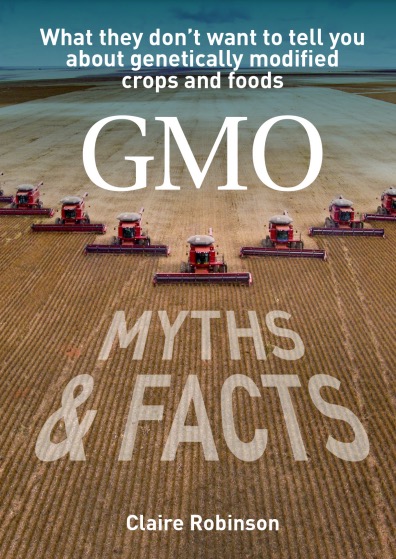Thanks to Hugh Warwick for this from the latest SPLICE.
Needless to say George’s book, 'Captive State' on the corporate take-over of Britain is a must for anyone interested in understanding the forces underpinning the global GM debate. It has several, very well-referenced, chapters of particular relevance to GE.
* * *
In the following extracts from George Monbiot’s latest book, CaptiveState, he reveals how the regulatory balance has been shifted in favour of corporate interest and against that of the consumer.
In April 1997, just before the General Election, Britain’s Conservative government quietly agreed to raise the permitted levels of a chemical called glyphosate in soya beans destined for human consumption. The decision was an extraordinary one, not only because permitted levels of
chemical residues are usually reduced over time rather than raised, but also because this particular one was raised by a staggering 200 times, 200,000 per cent.
Glyphosate is an organophosphate, and the active ingredient of Roundup, the world’s best-selling herbicide, manufactured by Monsanto.
Glyphosate is also said by some medical authorities to pose significant dangers to human health. In 1999, the Journal of the American Cancer Society reported that exposure to glyphosate led to increased risks of contracting a type of cancer called non-Hodgkin’s lymphoma, or NHL. NHL has increased in the United States by 80 per cent since the early 1970s. This has been linked to long-term exposure to pesticide residues.
Studies by researchers at the University of California, Berkeley, suggest that the chemical is also the third most commonly reported cause of pesticide illness among farm workers, and the commonest among gardeners.
Monsanto’s biggest genetically modified crop is its ‘Roundup Ready’ soya bean. The bean has been engineered to resist applications of glyphosate. It allows farmers to spray their fields with this total herbicide not only before the crop has been planted, but also while the crop is growing. The
genetically engineered soya plants are unaffected, but all the weeds are wiped out. It might help the farmer, but at a cost: the soya plants may absorb some of the glyphosate sprayed on them.
Throughout the late 1990s, Monsanto had been lobbying to raise the permitted glyphosate levels in soya beans. It persuaded Codex Alimentarius and the America and UP governments to agree to its request to lift 20 milligrams per kilogram of beans.
The Labour Agriculture Minister in Britain’s House of Lords, Lord Donoughue, later explained that “The low level prevented the import of soya treated in this way from, say, the United States. When that issue was raised, the level was increased by 200 to make it a more relevant level.” But he could not reveal any details of how Monsanto had won this extraordinary concession “because the matter was conducted under the previous administration and all such information is kept secret.”
When the soya products derived from ‘Roundup Ready’ beans are processed, the DNA and proteins which distinguish them from conventional beans are broken down. Thanks to Dr Cunningham’s interventions [then the Agriculture Minister] during Britain’s presidency of the European Union, they are, therefore, exempt from labelling. But while their DNA and protein content might be identical, they could contain significant quantities of glyphosate. Jack Cunningham’s legislation, in other words, ensures that the consumer is unable to distinguish between food which is likely to be largely free of glyphosate, and food which might contain high concentrations of the chemical.
It is worth noting that until he became Secretary of State for Agriculture, Jack Cunningham was retained as a paid consultant to an agrochemicals company called Albright and Wilson. Albright and Wilson is a member of the Chemical Industries Association, which lobbies for the deregulation of pesticides.
-------------------------------------------------------------------------
In 1999, for example, demand for organic food in Britain outstripped domestic supply by 200 per cent, and was growing exponentially. Demand for genetically engineered food was approximately zero - in fact there was sustained consumer pressure for GM ingredients to be removed from
food wherever possible.
One might have imagined that if the government were to invest in agricultural research, it would favour sectors in which demand was unmet, rather than those in which existing supplies could not be sold. But in 1999 government funding for research into agricultural applications of biotechnology amounted to £52m, while its funding for research into organic farming totalled just £1.7m.
In the same year, the government allocated £13m “to improve the profile of the biotech industry”. Its ‘Bio-Wise’ programme asked companies for “examples of biotechnology work within industry”. It would “publicise these as Case Studies or in press article” in order to “provide information on the financial and environmental benefits of biotechnology.” The government has also awarded grants to “promote better exploitation of intellectual property” in the biotechnology industry and has allocated £15m to help British researchers build up ‘gene libraries’ which can be commercialized by biotechnology companies.
...
Captive State, The Corporate Takeover of Britain, by George Monbiot.
Published by Macmillan, £12.99. ISBN 0-333-90164-9
[can be ordered from] http://www.captivestate.com
---
as published in Splice -
www.geneticsforum.org.uk









